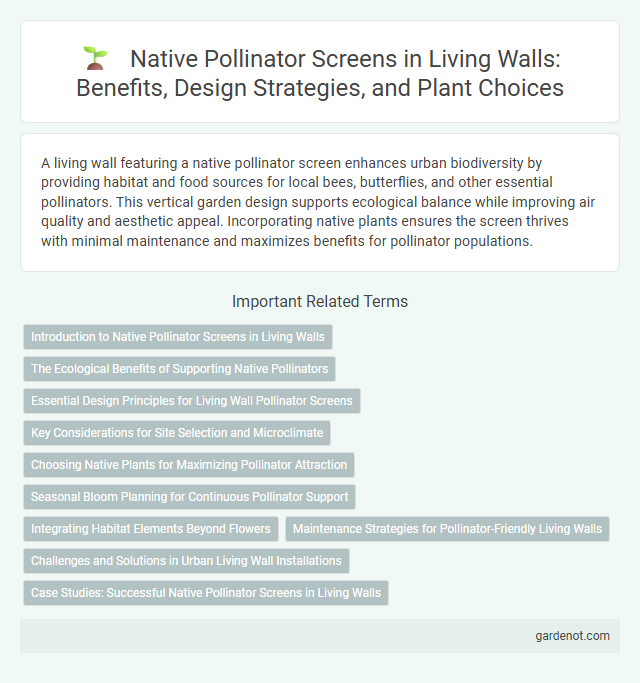A living wall featuring a native pollinator screen enhances urban biodiversity by providing habitat and food sources for local bees, butterflies, and other essential pollinators. This vertical garden design supports ecological balance while improving air quality and aesthetic appeal. Incorporating native plants ensures the screen thrives with minimal maintenance and maximizes benefits for pollinator populations.
Introduction to Native Pollinator Screens in Living Walls
Native pollinator screens integrated into living walls enhance urban biodiversity by providing essential habitats for bees, butterflies, and other pollinators. These screens utilize native plant species specifically selected to attract and support local pollinator populations, improving ecological connectivity and promoting pollination services in urban environments. Incorporating native pollinator screens into living walls fosters sustainable green infrastructure and contributes to the preservation of native pollinator species.
The Ecological Benefits of Supporting Native Pollinators
The Native pollinator screen enhances biodiversity by providing essential habitats and food sources for native bees, butterflies, and other pollinators, crucial for maintaining healthy ecosystems. Supporting native pollinators through designed living walls increases pollination efficiency for local flora, boosting plant reproduction and overall environmental resilience. This ecological approach also aids in preserving genetic diversity and improving crop yields in urban and suburban settings.
Essential Design Principles for Living Wall Pollinator Screens
Native pollinator screens in living walls must prioritize plant diversity featuring native flowering species that provide continuous bloom cycles to sustain local pollinators like bees, butterflies, and hummingbirds. Structural design should ensure adequate sunlight exposure, airflow, and water drainage to create optimal habitats while preventing fungal growth or plant stress. Incorporating layered vegetation and avoiding invasive species enhances ecosystem resilience, supporting pollinator health and biodiversity conservation within urban environments.
Key Considerations for Site Selection and Microclimate
Selecting a site for a native pollinator screen requires analyzing sunlight exposure, wind patterns, and local flora to ensure optimal habitat conditions. Consider microclimate factors such as temperature variations, humidity levels, and soil moisture that support pollinator activity and native plant health. Positioning the screen in sheltered areas with diverse vegetation enhances pollinator attraction and long-term ecological benefits.
Choosing Native Plants for Maximizing Pollinator Attraction
Selecting native plants for a living wall enhances pollinator attraction by providing essential nectar and pollen resources tailored to local pollinator species. Native plant varieties like goldenrod, coneflowers, and milkweed support native bees, butterflies, and other pollinators by promoting biodiversity and ecosystem resilience. Incorporating a diverse mix of flowering periods in a native pollinator screen maximizes pollinator visits throughout the growing season.
Seasonal Bloom Planning for Continuous Pollinator Support
A native pollinator screen designed with seasonal bloom planning ensures continuous availability of nectar and pollen resources throughout the year, supporting diverse pollinator species such as bees, butterflies, and hummingbirds. Selecting a variety of native plants that flower sequentially from early spring to late fall maximizes habitat value and promotes ecological resilience. This strategy enhances pollinator health, improves biodiversity, and contributes to sustainable urban ecosystems.
Integrating Habitat Elements Beyond Flowers
Native pollinator screens enhance biodiversity by incorporating diverse habitat elements such as nesting sites, water sources, and shelter alongside flowering plants. These integrated features support the full lifecycle of pollinators, promoting healthy populations of bees, butterflies, and other beneficial insects. Utilizing native plant species and structural components ensures habitat suitability and ecological balance within living wall systems.
Maintenance Strategies for Pollinator-Friendly Living Walls
Native pollinator screens in living walls benefit from regular pruning to prevent overgrowth and ensure flower accessibility, promoting effective pollination. Applying organic mulches and controlled irrigation helps maintain soil moisture without fostering fungal diseases, supporting native pollinator health. Periodic checks for invasive species and timely removal of spent blooms encourage continuous blooming cycles essential for pollinator attraction and habitat sustainability.
Challenges and Solutions in Urban Living Wall Installations
Urban living wall installations face challenges such as limited space, air pollution, and fluctuating microclimates that hamper native pollinator habitats. Incorporating diverse native plant species and designing modular, maintenance-friendly structures enhance habitat resilience and support pollinator biodiversity. Advanced irrigation systems and strategic placement of flowering plants optimize moisture levels and attract essential native pollinators like bees and butterflies.
Case Studies: Successful Native Pollinator Screens in Living Walls
Case studies of native pollinator screens in living walls demonstrate increased biodiversity and improved ecosystem services in urban environments. Implementations in cities like Portland and Toronto show significant boosts in native bee populations and pollination rates when tailored plant species are integrated into green wall systems. Data from these projects highlight improved air quality and enhanced habitat connectivity as critical benefits of native pollinator screens in living walls.
Native pollinator screen Infographic

 gardenot.com
gardenot.com